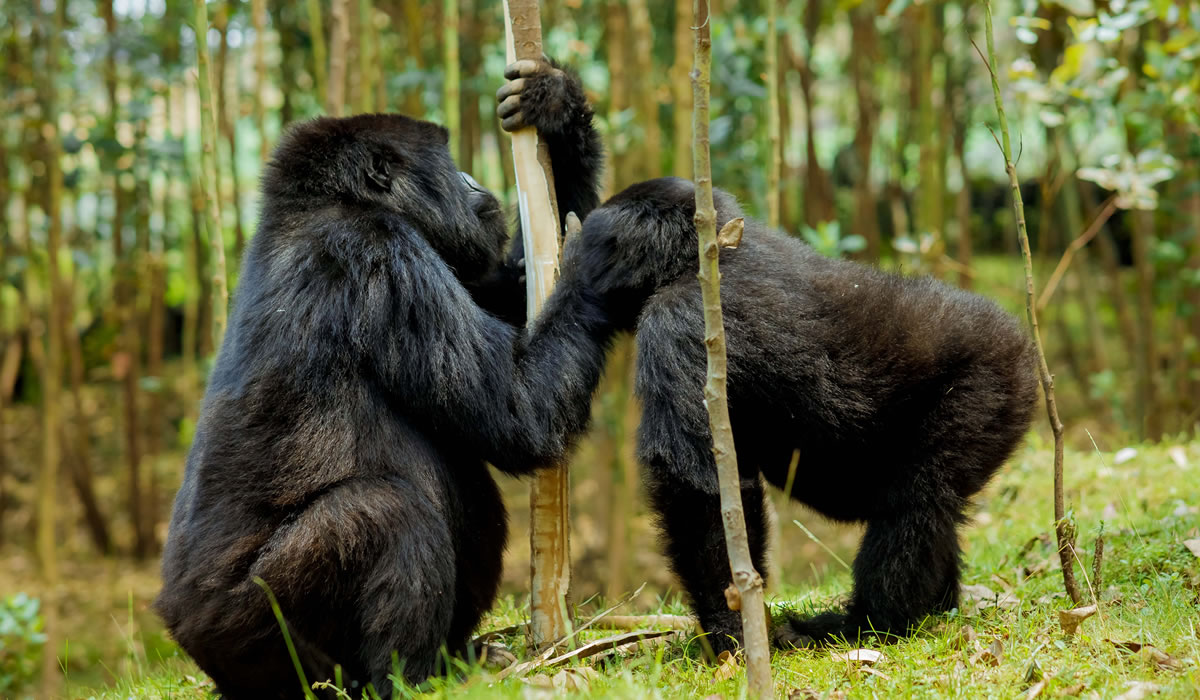Gorilla trekking in Volcanoes National Park is one of the most extraordinary wildlife experiences in the world. Nestled in the mist-shrouded Virunga Mountains of northwestern Rwanda, Volcanoes National Park (Parc National des Volcans) offers visitors a rare chance to observe endangered mountain gorillas (Gorilla beringei beringei) in their natural habitat. This once-in-a-lifetime adventure combines awe-inspiring nature, close encounters with powerful yet gentle primates, and deep insights into conservation efforts that have become a global model for ecotourism.
This comprehensive article delves into everything travelers need to know about gorilla trekking in Volcanoes National Park, including the park’s history and ecology, gorilla families, permit procedures, trek logistics, best times to visit, packing tips, and the broader significance of gorilla tourism in Rwanda’s conservation and development journey.

Overview of Volcanoes National Park
Volcanoes National Park is part of the larger Virunga Conservation Area, which stretches across Rwanda, Uganda, and the Democratic Republic of the Congo. It was established in 1925 as Africa’s first national park to protect the mountain gorillas living in the dense forests of the Virunga Mountains. Covering approximately 160 square kilometers, the park encompasses five of the eight Virunga volcanoes: Karisimbi, Bisoke, Muhabura, Gahinga, and Sabyinyo.
The park is not only renowned for its gorillas but also for its rich biodiversity, which includes golden monkeys, forest elephants, buffaloes, over 170 bird species, and a lush environment of bamboo forests, hagenia woodlands, and afro-alpine vegetation. It was also the base for pioneering primatologist Dian Fossey, whose research and conservation work brought global attention to the plight of mountain gorillas.
The Mountain Gorilla: An Endangered Icon
Mountain gorillas are a subspecies of the eastern gorilla and are found only in the high-altitude forests of the Virunga Mountains and Uganda’s Bwindi Impenetrable National Park. As of the latest census, the total population of mountain gorillas stands at just over 1,000 individuals, with around one-third of them residing in Volcanoes National Park.
Unlike their lowland relatives, mountain gorillas cannot survive in captivity, making in-situ conservation through protected areas and controlled tourism vital for their survival. They are herbivorous, largely gentle in nature, and live in close-knit family groups led by a dominant silverback male. Their social behavior, intelligence, and emotional expressions have captivated researchers and visitors alike.
The Gorilla Trekking Experience
Gorilla trekking in Volcanoes National Park begins at the Kinigi Visitor Center, located just outside the town of Musanze. Visitors are expected to arrive by 7:00 AM for a briefing session conducted by park rangers. During this time, trekkers are introduced to gorilla etiquette, safety guidelines, and the rules of engagement while with the gorillas.
Visitors are then divided into groups of up to eight people, each assigned to one of the 12 habituated gorilla families in the park. The assignment takes into consideration each group’s fitness level, age, and preferences, as some gorilla families live deeper in the forest and require longer hikes.
Accompanied by experienced guides and trackers, trekkers set out into the forest around 8:00 AM, following narrow, muddy trails that meander through dense vegetation and up steep slopes. The duration of the trek can vary widely from 30 minutes to over four hours depending on the location of the gorilla family on that day.
Once the gorillas are located, visitors are allowed to spend one hour observing them at close range, usually within 7 meters, though the gorillas often come closer out of curiosity. This hour is magical watching gorillas groom each other, play, nurse their young, and go about their daily routine is an intimate and humbling experience that leaves a lasting impact.
Gorilla Families in Volcanoes National Park
As of 2025, Volcanoes National Park has 12 habituated gorilla families available for trekking:
- Susa A Group – The largest and one of the most famous, once studied by Dian Fossey.
- Karisimbi Group (Susa B) – A split from the original Susa Group, known for challenging treks.
- Amahoro Group – Peaceful in nature and found on the slopes of Mount Bisoke.
- Umubano Group – A breakaway from the Amahoro group, led by a dominant silverback.
- Sabyinyo Group – Known for being close to the park boundary and ideal for shorter treks.
- Agashya Group – Also called “Group 13,” known for its dynamic movements.
- Kwitonda Group – Migrated from the Democratic Republic of Congo.
- Hirwa Group – Initially formed by members from Sabyinyo and Group 13.
- Bwenge Group – Featured in the movie Gorillas in the Mist.
- Ugenda Group – Frequently on the move; “Ugenda” means “mobile” in Kinyarwanda.
- Muhoza Group – A newer group known for good photographic opportunities.
- Igisha Group – Another group ideal for moderately strenuous treks.
Each family has its own distinct character, social dynamics, and home range. Assignments to these groups are managed by the park authorities to ensure visitor safety and minimize stress on the animals.
Gorilla Trekking Permits
Gorilla trekking in Rwanda requires a permit issued by the Rwanda Development Board (RDB). As of 2025, a gorilla trekking permit costs USD 1,500 per person per trek. While this may seem high, the fee supports conservation, anti-poaching patrols, veterinary care, and community development projects.
Best Time to Visit
Gorilla trekking in Volcanoes National Park can be enjoyed year-round, though conditions vary with the seasons:
- Dry Season (June to September, December to February): Best time for trekking. Trails are more accessible, and photography is easier due to better lighting.
- Wet Season (March to May, October to November): Lush greenery enhances the scenery, and permits may be easier to obtain. However, trails are muddy and more difficult to navigate.
Regardless of the season, early morning treks are the norm to maximize chances of locating the gorillas and to avoid afternoon rains.
Physical Fitness and Preparation
Gorilla trekking can be physically demanding, particularly for groups like Susa A and Karisimbi that live at higher elevations. Visitors should be in moderate to good physical shape and prepared for uneven, steep, and slippery terrain. Porters are available at the trailhead to carry bags, offer support, and enhance the overall experience. Hiring a porter not only provides physical assistance but also supports local livelihoods.
What to Pack and Wear
Proper gear ensures a more comfortable and enjoyable trek:
- Sturdy hiking boots with ankle support
- Rain jacket or poncho
- Long trousers and long-sleeved shirts for protection from nettles and insects
- Gaiters or long socks tucked over pants to keep out ants
- Gardening gloves for grabbing onto branches
- Daypack with water, snacks, and camera gear
- Binoculars and insect repellent
- Walking stick (often provided by guides)
Photography is allowed without flash, and silence is encouraged to avoid startling the gorillas.
Conservation and Community Impact
Gorilla tourism is the backbone of Rwanda’s conservation model. Revenue from trekking permits is reinvested into park management, anti-poaching units, and veterinary care under initiatives like the Gorilla Doctors program. Additionally, 10% of permit revenue is shared with surrounding communities to build schools, health clinics, and infrastructure creating tangible benefits that foster coexistence.
The success of gorilla conservation in Rwanda is one of Africa’s leading wildlife stories, with the mountain gorilla population steadily increasing and once-poachers now working as porters, guides, and rangers.
Gorilla trekking in Volcanoes National Park is not just an adventure, it is a deeply transformative experience that connects you to nature, conservation, and the enduring spirit of Rwanda. Few wildlife encounters can rival the emotion of looking into the eyes of a mountain gorilla, recognizing the shared intelligence, curiosity, and family bonds that link us.
Rwanda’s commitment to sustainable tourism has created a world-class gorilla trekking experience, protecting a critically endangered species while uplifting local communities. For travelers seeking meaning in their journeys, gorilla trekking is more than a tick on a bucket list it’s a profound story of hope, resilience, and the harmonious balance between humanity and the wild.

